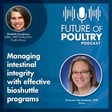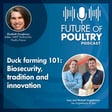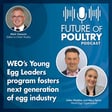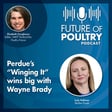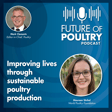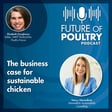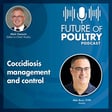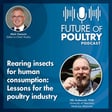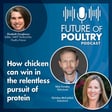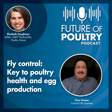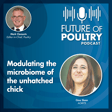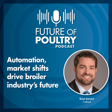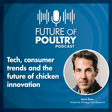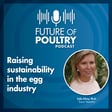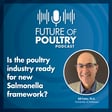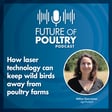Become a Creator today!Start creating today - Share your story with the world!
Start for free
00:00:00
00:00:01

Protecting intestinal health through seasonal challenges
Elizabeth Doughman, editor, WATT PoultryUSA and Poultry Future, and Scott Gustin, DVM, U.S. poultry technical leader, Elanco, discuss the importance of seasonal management programs.
Transcript
Introduction and Sponsorship
00:00:00
Speaker
Hello and welcome to the Future of Poultry podcast series.
00:00:12
Speaker
Hello, I'm Elizabeth Duffman, the editor of What Poultry USA and Poultry Future. This Future of Poultry podcast is brought to you by Elanco. Elanco Animal Health Incorporated is a global leader in animal health dedicated to innovating and delivering products and services to prevent and treat disease in farm animals and pets.
00:00:31
Speaker
creating value for farmers, pet owners, veterinarians, stakeholders, and society as a whole. With over 70 years of animal health heritage, Alanco is committed to helping their customers improve the health of animals in their care, while also making a meaningful impact on local and global communities.
00:00:49
Speaker
Alanco is driven by its vision of food and companionship enriching life and Alanco healthy purpose, all to advance the health of animals, people, the planet, and enterprise. Learn more at alanco.com.
Meet the Guest: Dr. Scott Gustin
00:01:01
Speaker
In today's episode, my guest is Dr. Scott Gustin, U.S. Poultry Technical Leader for Elanco. Thanks for joining us today, Scott. Yeah, thanks for having me.
Seasonal Changes in Poultry Management
00:01:11
Speaker
What effect do seasonal changes have on management and coccidiosis control?
00:01:16
Speaker
Typically, seasons influence conditions in the house by how much water or moisture is deposited and then how much can be removed through ventilation. More moisture in general means more sporulation of OSS and more proliferation of bacterial challenges.
00:01:33
Speaker
But it's easy to say, okay, certain times of the year give certain conditions. If you're in South Central broiler production right now, humidity's low, the highs are in the eighties. And you'd say we're almost experiencing summer like temperatures in the fall.
00:01:46
Speaker
So moisture is easy to remove. You can keep litter dry. And really this is a favorable environment for managing coccidiosis provided everything else in the program stays the same. It won't be long, cooler temperatures will start to set in we'll have more ambient humidity.
00:02:02
Speaker
And then you also have mother nature is going to allow for better growth rates and efficiencies, but at the same time, litter moisture and coccidiosis overall disease challenges can be greater of that time of year.
00:02:12
Speaker
Clostridial diseases tend to favor larger animals in a population and more pounds at the same age in a chicken house of chicken also means management must be really on the top of their game.
00:02:24
Speaker
But typically, as far season goes, ambient humidity is the one of the greatest challenges for producers out there.
HTSI Data Analysis on Seasonal Effects
00:02:31
Speaker
You guys have recently done a fairly large analysis of HGSI data looking at seasonal changes. What have you found?
00:02:37
Speaker
Well, we looked at over 10,000 flocks in our HTSI database, which is a health tracking system database from 2021 through midway of 2025. Really, this is building on some work that Lynn Warren and Francine Van Zembeek have presented before.
00:02:53
Speaker
We split the year into astronomical seasons. So winter was December twenty first through March 20th. Spring, March 21st to June 21st, summer, June 22nd to September 21st and fall being September 22nd to December 20th.
00:03:12
Speaker
We looked at one really big parameter that I would say most consider the most impactful coccyx species and the best way of evaluating it and that being microscopic Imeria maxima.
00:03:25
Speaker
um I had some curiosity just to see if we've changed things. Our bird sizes and our cycle length has gradually gotten longer. Maybe there's more cool cell usage in summer that might and affect seasons and greater incidence of microscopic maxima.
00:03:40
Speaker
A conventional chicken wisdom would typically say that maxima levels be lower in the summer and winter would be the highest. And our data did prove that they were. But what was striking is that the differences, although statistically significant, those differences were relatively small.
00:03:57
Speaker
So summer is not necessarily where the living is easy any longer. Summer incidence of average microscopic maximum was only 8% lower than in spring and fall.
00:04:09
Speaker
And winter, which we thought would be the highest incidence, was only 2% higher than spring and fall. The same was true for average score, but again, very small differences. Typical score during spring and fall, winter was 0.4, and the only change was up to a 0.3 in the summer.
00:04:27
Speaker
And this was regardless of which coccidiosis control program was being employed. The overall relationship still held true. So I guess at the end of the day, we just can't take our eyes off the toddler at any time of the year when it comes to
Winter Performance Trends and Challenges
00:04:40
Speaker
COCSI.
00:04:40
Speaker
What trends do we typically see reflected in the HTSI as we head into the cooler months? Is there a true winter slide when it comes to performance? Yeah, so again, looking at some data, some benchmarking data and really prior to last winter, because I think AMPV really made for difficult conditions, high mortality, and maybe wasn't the best baseline to measure against.
00:05:05
Speaker
But the typical slide in performance from ideal growing conditions, birds settling in September versus current performing months, like birds settle in March.
00:05:15
Speaker
You can really expect that winter slide to be just over six points of loss feed conversion. When you look at the top quartile producers, there's still, the change is not as great, but it's still five and a half points of feed conversion.
00:05:29
Speaker
In the industry, we try and remove sources of variability through housing, nutrition, COCSE control, but there's ah still a big change in efficiency that we have to overcome and try to manage as best we can.
00:05:42
Speaker
Some of this variability, this winter slide will be obviously determined by where your location is. But I think the biggest takeaway is no matter where you're at, is knowing your typical slide in the winter and being aware of what what might need to be investigated further.
Winter Management Strategies
00:05:58
Speaker
So what are the biggest watchouts for producers as winter takes hold with regards to programs and husbandry? So when you look at benchmarking data, there's a lot of changes that occur in any given year.
00:06:09
Speaker
May have a breed change, ingredient values, programs, new diseases, emerging diseases. But first I think you have to recognize there is a problem. and And I think you have to do that with good benchmarking internal and external data for your region.
00:06:24
Speaker
If you're in December, January, and you've already lost eight points of fee conversion adjusted for weight, it's really time to critically look at your programs and develop an action plan. It may be your winter temperature curve, could be new change to a program you didn't have last year.
00:06:40
Speaker
You really need to go out and verify what is happening. It is actually happening on all the farms. Are your ventilation programs really accomplishing what they need to? If mortality is up during the winter, where is that mortality occurring? What value is that in terms of fee conversion?
00:06:54
Speaker
But by the same token, if you've gotten four points worse when it's in December, I would say that now isn't the time to go and throw the baby out with the bath water and really change every program.
00:07:06
Speaker
The key takeaway is knowing your normals because we make a lot of mistakes simply by overreacting and changing for the sake of change. Last winter would not probably be the best but baseline for most complexes, but it's always better to rely on good data where possible.
00:07:23
Speaker
And if we at Elanco can be a part of that data solution, please let us know. Thanks again, Scott, and thanks to you for tuning in. For more information on the solutions discussed here today, visit Alanco at alanco.com.
00:07:36
Speaker
For more episodes of the Future Poultry podcast, please like and subscribe on wattpoultry.com or wherever you access podcasts.

